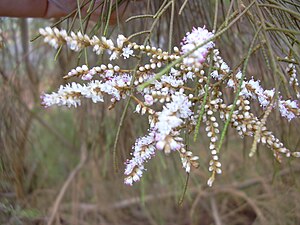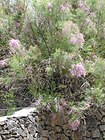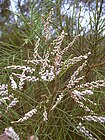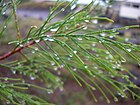Note: This is a project under development. The articles on this wiki are just being initiated and broadly incomplete. You can Help creating new pages.
Difference between revisions of "Tamarix aphylla"
| Line 8: | Line 8: | ||
==Chemical Composition== | ==Chemical Composition== | ||
| − | <ref name="chemical composition"/> | + | It contains Methanol, chloroform, petroleum ether, acetone and diethyl etc.<ref name="chemical composition"/> |
==Common names== | ==Common names== | ||
| Line 68: | Line 68: | ||
<references> | <references> | ||
| − | <ref name="chemical composition">[ | + | <ref name="chemical composition">[https://link.springer.com/article/10.1007/s13369-015-1900-x Chemical constituents]</ref> |
<ref name="Leaf">[Morphology]</ref> | <ref name="Leaf">[Morphology]</ref> | ||
Latest revision as of 20:51, 18 August 2020
Athel tamarisk is an upright, evergreen tree with drooping twigs and a dense spreading crown with several heavy large limbs; it usually grows 8 - 12 metres tall, but occasional specimens up to 18 metres are recorded. The bole can be 60 - 80cm in diameter.
Contents
- 1 Uses
- 2 Parts Used
- 3 Chemical Composition
- 4 Common names
- 5 Properties
- 6 Habit
- 7 Identification
- 8 List of Ayurvedic medicine in which the herb is used
- 9 Where to get the saplings
- 10 Mode of Propagation
- 11 How to plant/cultivate
- 12 Commonly seen growing in areas
- 13 Photo Gallery
- 14 References
- 15 External Links
Uses
Parts Used
Chemical Composition
It contains Methanol, chloroform, petroleum ether, acetone and diethyl etc.[2]
Common names
| Language | Common name |
|---|---|
| Kannada | |
| Hindi | |
| Malayalam | |
| Tamil | |
| Telugu | |
| Marathi | |
| Gujarathi | |
| Punjabi | |
| Kashmiri | |
| Sanskrit | |
| English |
Properties
Reference: Dravya - Substance, Rasa - Taste, Guna - Qualities, Veerya - Potency, Vipaka - Post-digesion effect, Karma - Pharmacological activity, Prabhava - Therepeutics.
Dravya
Rasa
Guna
Veerya
Vipaka
Karma
Prabhava
Habit
Identification
Leaf
| Kind | Shape | Feature |
|---|---|---|
Flower
| Type | Size | Color and composition | Stamen | More information |
|---|---|---|---|---|
| {{{5}}} |
Fruit
| Type | Size | Mass | Appearance | Seeds | More information |
|---|---|---|---|---|---|
Other features
List of Ayurvedic medicine in which the herb is used
Where to get the saplings
Mode of Propagation
Seeds, Cuttings of half-ripe wood, Cuttings of mature wood.
How to plant/cultivate
A plant of the arid and semi-arid subtropics and tropics, where it is found at elevations up to 1,400 metres. It grows best in areas where annual daytime temperatures are within the range 27 - 40°c, but can tolerate 8 - 50°c.[4]
Commonly seen growing in areas
Coastal scrubland in saline soils, Sandy soil.
Photo Gallery
References
- ↑ Indian Medicinal Plants by C.P.Khare
- ↑ Chemical constituents
- ↑ [Morphology]
- ↑ Cultivation
External Links
- Ayurvedic Herbs known to be helpful to treat Eczema
- Ayurvedic Herbs known to be helpful to treat Skin diseases
- Herbs with Bark used in medicine
- Herbs with Twigs used in medicine
- Habit - Evergreen tree
- Index of Plants which can be propagated by Seeds
- Index of Plants which can be propagated by Cuttings of half-ripe wood
- Index of Plants which can be propagated by Cuttings of mature wood
- Herbs that are commonly seen in the region of Coastal scrubland in saline soils
- Herbs that are commonly seen in the region of Sandy soil
- Herbs





